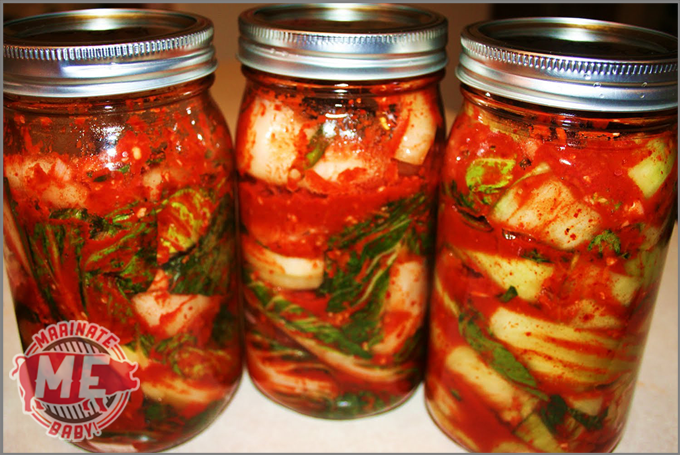
Kimchi
Amazing Korean Kimchi
Ingredients
- 1 lb Napa Cabbage or Bok Choy
- 1 Small Daikon Radish
- 1 Carrot
- 1 Small Onion
- 1/2 Fresh Ginger 1/2-inch finger
- 4 cloves garlic
- 1 tablespoon Fish Sauce
- 2 Taplespoon Korean Hot Pepper Singsong brand
- 4 Tablespoons Kosher Salt
- 6 Cups Water bottled or filtered water
Instructions
- Make a Brine by combining the salt and the 6 cups of water in a medium-large food safe bucket. Stir until the salt has completely dissolved.
- In a colander, wash (tap water) and dry all of the vegetables. Slice the the cabbage into bite size chunks. Julienne or grate the carrot, radish and ginger. Quarter the onion.
- In a very large bowl, add the cabbage, carrot, radish and ginger and cover with the brine mixture. Place a plate on top to help keep the vegetables submerged. Let this brine for at least 2 hours.
- In a food processor place the garlic, onion, fish sauce, and pepper and pulse to combine. Add a little bit of the brine mixture as needed until the mixture forms a think paste. Cover with plastic wrap and place in the refrigerator until the vegetables have completed their 2 hours in the brine.
- Once the brine is complete, taste the cabbage. The texture of the cabbage should have softened a bit, however some of the crunch should still be present. The taste should be pleasantly salty, like the taste of ocean water. You can adjust the seasoning at this point by letting the cabbage sit for an additional hour in the brine, or if you think it's too salty you can rinse the cabbage.
- Drain your vegetables and reserve the brining liquid.
- While wearing food safe gloves, in a large bowl add the chile paste to the vegetables and combine until completely combined.
- In a quart sized jar or pickling container, pack the Kimchi mixture tightly. Tamp down the vegetables to remove any air bubbles, make sure to leave at least 1 1/2 inches of space at the top of the jar.
- Add enough of the reserved brine mixture to cover the Kimchi and still leaving that same 1 1/2 inch of space to allow for expansion during fermentation.
- If you do not use an airlock system, seal the jar loosely to let the air escape. If you are using an airlock system, seal the jar tightly, insert the airlock and add water to the fill line.
- Let the Kimchi mixture sit for one or two days, in a dark place at about room temperature. You might see some bubbles forming int he jar or bubbling through the airlock system, this is a good thing. Taste the Kimchi at this point and see how it is progressing. At this point the taste should be a bit hot or a tangy taste. The flavor will get progressively stronger as it sits, so once the flavor is where you would like it. Remove the airlock system, and seal the jar and place it in the refrigerator.
- Recommended: Let the Kimchi sit in the refrigerator for a week. This will mellow out the flavors a little bit. This recipe will keep in the refrigerator for weeks.
Notes
The use of Sea or Kosher salt and filtered water isn't just a chef/foodie quirk. It actually has food science to back it up. The use of iodine and anti-caking agents (table salt), and chlorine (water) will mess up the fermentation process of Kimchi. These additives are mean to kill the fermentation bacteria. Just like Sourdough, some bacteria are good for food.